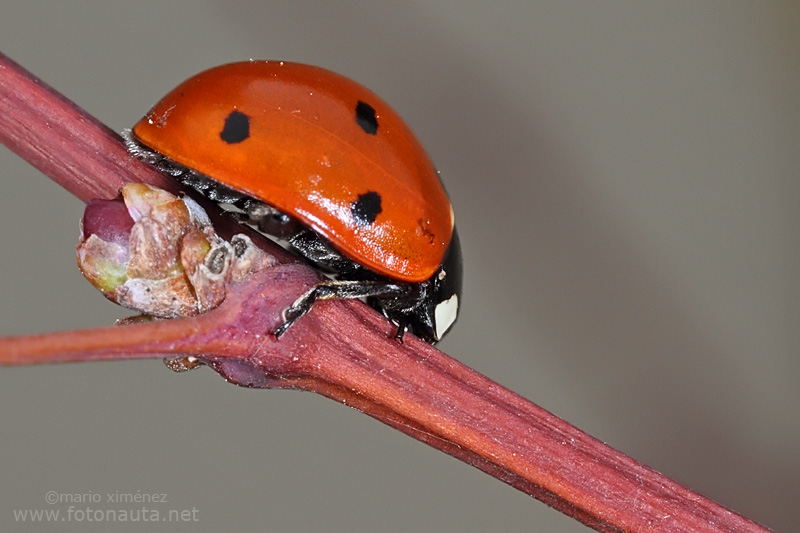

At this point, the elytra, which cover the wings, are very soft and lack color. Before the fourth instar pupates, it stops eating for 24 hours and attaches itself to a surface, such as a leaf, with the tip of its body. There are four instars for this species, and the time of each instar is effected by the amount of aphid prey and temperature.

As the instars develop, they shift from sucking the liquids from aphids, and instead eat the entire insect. Larvae go through several stages called instars.

After the egg hatches, a larva will stay with its egg casing, eat it, and eat any nearby eggs that haven't hatched. Its life stages are egg, larva, pupa, and adult.
 Range elevation sea level to 1500 m to 4921.26 ftĬoccinella septempunctata goes through complete metamorphosis. These animals are found in the following types of habitat. ( Cantrell, 2011 Hodek and Michaud, 2008 Hoebeke and Wheeler, 1983 Honek and Martinkova, 2005 Honek, et al., 2007 Turnock, et al., 2003) The typical habitat for Coccinella septempunctata during the winter is an open area with sheltering boulders, small clusters of plants, or hedgerows of dense grasses that are south-facing, with the most possible sunlight hours. This normally includes small plants, shrubs and trees in open fields, grasslands, marshes, farm land, suburban gardens and parks. ( Gordon, 1985 Honek and Martinkova, 2005 Maredia, et al., 1992)Ĭoccinella septempunctata can be found wherever large numbers of prey, particularly aphids, are present. Since then, this species has become one of the most common lady beetle species across North America. Populations continued to appear in the eastern U.S. However, this population was thought to have been started by accident. None of those introductions were though to be successful in creating a population until 1973 when a population was found in Hackensack Meadowland, New Jersey. septempunctata was intentionally brought to the United States between 19 to control the populations of crop damaging aphids. Range length 6.50 to 7.8 mm 0.26 to 0.31 inĬoccinella septempunctata is originally from Europe and Asia, but it is now found throughout the Middle East, India and North America (U.S. ( "Coccinella septempunctata L.", 2011 Cantrell, 2011) It is about the size of the adult Coccinella septempunctata. It has a hard exoskeleton which develops from the last larval stage. The pupa is slate grey to black, sometimes having white or orange markings on the outside. ( "Coccinella septempunctata L.", 2011 Angalet, et al., 1979 Beverley, et al., 2012 Cantrell, 2011) septempunctata can be several colors, depending on temperature, but they are generally dark with many body segments. ( "Coccinella septempunctata L.", 2011 Cantrell, 2011 Hodek and Michaud, 2008) The eggs of Coccinella septempunctata are small (1mm long) and oval-shaped. Males have small hairs on the last segment of the body. There are three spots on each elytra, though they can vary in placement. There is one spot near the top of the elytra that extends across the two elytra, and there are two white patches on either side above this spot. It usually has seven black spots, though it can range from 0 to 9. This species can be identified by several unique characteristics. Coccinella septempunctata looks like a typical ladybug: it is medium sized, has orangish-red elytra (wing coverings) and black spots.
Range elevation sea level to 1500 m to 4921.26 ftĬoccinella septempunctata goes through complete metamorphosis. These animals are found in the following types of habitat. ( Cantrell, 2011 Hodek and Michaud, 2008 Hoebeke and Wheeler, 1983 Honek and Martinkova, 2005 Honek, et al., 2007 Turnock, et al., 2003) The typical habitat for Coccinella septempunctata during the winter is an open area with sheltering boulders, small clusters of plants, or hedgerows of dense grasses that are south-facing, with the most possible sunlight hours. This normally includes small plants, shrubs and trees in open fields, grasslands, marshes, farm land, suburban gardens and parks. ( Gordon, 1985 Honek and Martinkova, 2005 Maredia, et al., 1992)Ĭoccinella septempunctata can be found wherever large numbers of prey, particularly aphids, are present. Since then, this species has become one of the most common lady beetle species across North America. Populations continued to appear in the eastern U.S. However, this population was thought to have been started by accident. None of those introductions were though to be successful in creating a population until 1973 when a population was found in Hackensack Meadowland, New Jersey. septempunctata was intentionally brought to the United States between 19 to control the populations of crop damaging aphids. Range length 6.50 to 7.8 mm 0.26 to 0.31 inĬoccinella septempunctata is originally from Europe and Asia, but it is now found throughout the Middle East, India and North America (U.S. ( "Coccinella septempunctata L.", 2011 Cantrell, 2011) It is about the size of the adult Coccinella septempunctata. It has a hard exoskeleton which develops from the last larval stage. The pupa is slate grey to black, sometimes having white or orange markings on the outside. ( "Coccinella septempunctata L.", 2011 Angalet, et al., 1979 Beverley, et al., 2012 Cantrell, 2011) septempunctata can be several colors, depending on temperature, but they are generally dark with many body segments. ( "Coccinella septempunctata L.", 2011 Cantrell, 2011 Hodek and Michaud, 2008) The eggs of Coccinella septempunctata are small (1mm long) and oval-shaped. Males have small hairs on the last segment of the body. There are three spots on each elytra, though they can vary in placement. There is one spot near the top of the elytra that extends across the two elytra, and there are two white patches on either side above this spot. It usually has seven black spots, though it can range from 0 to 9. This species can be identified by several unique characteristics. Coccinella septempunctata looks like a typical ladybug: it is medium sized, has orangish-red elytra (wing coverings) and black spots.








 0 kommentar(er)
0 kommentar(er)
